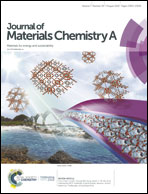Significant average ZT enhancement in Cu3SbSe4-based thermoelectric material via softening p–d hybridization†
Abstract
As a tellurium- and lead-free compound, Cu3SbSe4 is a promising thermoelectric material with relatively high Seebeck coefficient and low thermal conductivity. Here, an effective strategy of weakening p–d hybridization was proposed and demonstrated to enhance the thermoelectric properties for Cu3SbSe4via Ag substitution. This strategy performs a multiple role in high thermoelectric performance, boosting both maximum and average ZT: (1) increase the hole concentration due to the weakened Cu–Se bonding, (2) enlarge the energy gap Eg, putting off the bipolar diffusion, (3) increase the density of states effective mass, and (4) reduce the lattice thermal conductivity mainly due to the large strain fluctuations. As a consequence, a peak ZT ∼ 0.9 at 623 K and a high average ZT above 0.5 for the range 298–623 K can be achieved in a Cu2.85Ag0.15SbSe4 sample. This study provides a new strategy of softening p–d hybridization to boost the thermoelectric performance of Cu3SbSe4 by the synergistic regulation of charge carrier and phonon transports, which is also a meaningful guidance to achieve high thermoelectric performance in other copper-based chalcogenides.



 Please wait while we load your content...
Please wait while we load your content...